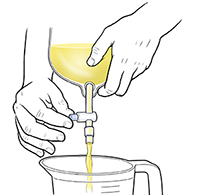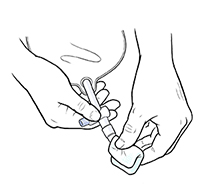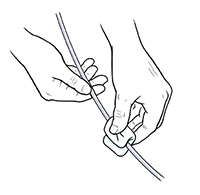Taking Care of Your Urinary Catheter Bag
You have an indwelling urinary catheter. This drains urine from your bladder into a bag. The bag can be one that is used at your bedside. Or it can be a smaller bag that is strapped to your leg. Follow the steps below to care for a urinary bag.
Step 1. Drain the bag
-
Wash your hands well with soap and water to prevent infecting the urinary catheter and bag.
-
If the short drainage tube is inserted into a pocket on the bag, take the drainage tube out of the pocket.
-
Hold the drainage tube over a toilet or measuring container. Open the valve.
-
Don’t touch the tip of the valve or let it touch the toilet or container.
-
Wash your hands again.
-
Some bags are disposable while others may be cleaned. Ask your care team for advice for your bag.

Step 2. Clean the drainage tube
-
When the bag is empty, clean the tip of the drainage valve with an alcohol wipe.
-
Close the valve.
-
Reinsert the drainage tube into the pocket, if there is one.

Step 3. Clean your skin
-
Wash your hands well before and after cleaning your skin.
-
If you have a catheter (such as a Foley) that enters through the urethra, clean the urethral area with soap and water 1 time(s) daily as you were taught by your healthcare provider. You should also clean after every bowel movement to prevent infection.
-
Don't pull on the tubing when cleaning so you don’t injure the urethra.
-
Don’t apply antibiotic ointment or any other antibacterial product to the urethra.
-
Don’t use lubricant on the urethra.
-
Don’t apply powder to the genital area or to the tubing.
-
If you have a suprapubic catheter, your provider will tell you how to clean your skin around the catheter. This is a catheter that was surgically placed into the bladder through the lower belly (abdomen).
Step 4. Check and clean the catheter tubing
-
Check the tubing. If there are kinks, cracks, clogs, or you can’t see into the tubing, you’ll need to change to new tubing as you were shown by your healthcare provider.
-
If the current tubing can still be used, wash it with soap and water. Always wash the tubing in the direction away from your body. Don't pull on the tubing.
-
Dry the tubing with a clean washcloth or paper towel.

When to call your healthcare provider
Call your healthcare provider right away if you have any of these:
-
Little or no urine flowing into the bag
-
Urine leaking where the catheter enters the body
-
Pain, burning feeling, or redness where the catheter enters the body
-
Bloody urine (a trace of blood is normal)
-
Cloudy or bad-smelling urine, or sand-like grains in your urine
-
Pain in your lower back or lower belly (abdomen)
-
Your catheter falls out
-
Fever of 100.4° F ( 38°C ) or higher, or as advised by your provider
-
Shaking chills
Online Medical Reviewer:
Marc Greenstein MD
Online Medical Reviewer:
Melinda Murray Ratini DO
Online Medical Reviewer:
Rita Sather RN
Date Last Reviewed:
4/1/2024
© 2000-2024 The StayWell Company, LLC. All rights reserved. This information is not intended as a substitute for professional medical care. Always follow your healthcare professional's instructions.